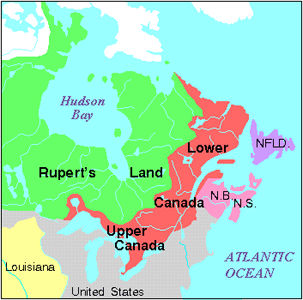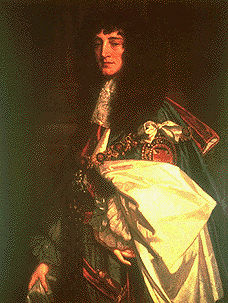Rupert’s Land was a vast territory of northern wilderness. It represented a third of what is now Canada. From 1670 to 1870, it was the exclusive commercial domain of the Hudson’s Bay Company(HBC) and the primary trapping grounds of the fur trade. The territory was named after Prince Rupert, the HBC’s first governor. Three years after Confederation, the Government of Canada acquired Rupert’s Land from the HBC for CAD$1.5-million (£300,000). It is the largest real estate transaction (by land area) in the country’s history. The purchase of Rupert’s Land transformed Canada geographically. It changed from a modest country in the northeast of the continent into an expansive one that reached across North America. Rupert’s Land was eventually divided among Quebec, Ontario, Manitoba, Saskatchewan, Alberta and the Northwest Territories.

The Fur Trade and the HBC
In the late 17th century, the fur trade in beaver pelts was growing in commercial importance in North America. Yet it was difficult for traders to reach the rich trapping grounds north of Lake Superior and beyond. They had to make challenging overland journeys from the Great Lakes or the St. Lawrence River. Two French explorers, Médard Chouart des Groseilliers and Pierre-Esprit Radisson, wanted to establish a trading base on the shores of Hudson Bay. Few Europeans had ever seen the northern “frozen sea.” It offered an easier water route into the heart of the continent’s best fur country.
Des Groseilliers and Radisson failed to interest the French government in their idea. So they took their scheme to England. A group of entrepreneurs and noblemen — including Prince Rupert, the King of England’s cousin — persuaded King Charles II to support the venture. In June 1668, two small ships were dispatched from England. One, the Nonsuch, reached Hudson Bay in September, with des Groseilliers on-board. He and his partners spent the following winter successfully trading with the Cree on the southern shores of James Bay.
The Nonsuch returned to England with a large cargo of furs. Additional ships were dispatched, with similar successful results. In 1670, the “Governor and Company of Adventurers of England Trading into Hudson’s Bay” (the Hudson’s Bay Company, or HBC) was created under a royal charter signed by Charles II.
Size and Reach
By today’s standards, the charter was breathtaking in reach. It gave the HBC and its merchant governors exclusive rights to trade — and to colonize — all the lands containing rivers flowing into Hudson Bay. In other words, the entire Hudson Bay drainage system. This amounted to an enormous territory in the heart of the continent. It comprised what is now northern Quebec and Labrador, northern and western Ontario, all of Manitoba, most of Saskatchewan, south and central Alberta, parts of the Northwest Territories and Nunavut, and small sections of the northern United States.
This private estate stretched from the Atlantic Ocean to the Rocky Mountains, and from the Prairies to the Arctic Circle. The area was five times larger than France. All 3.9 million sq. km of it was named Rupert’s Land, in honour of the King's cousin, Prince Rupert. He became the HBC’s first governor.

Indigenous People, Métis and Missionaries
The charter signed by King Charles II gave the HBC complete control of the territory. Almost no thought was given to the sovereignty of the many Indigenous peoples that had lived there for centuries. The HBC established forts and trading routes through much of the territory. The Cree, Assiniboine and other groups supplied the Company with furs, or acted as middlemen for other Indigenous fur suppliers. The Indigenous groups either took part in the growing trading economy or were directly employed by the HBC. The fur trade changed the Indigenous economy. Rather than hunting and trapping for subsistence, people now trapped in exchange for trade goods, including guns and alcohol.
Rupert’s Land also became home to a new people of mixed European and Indigenous heritage, the Métis. They were active participants in the fur trade and helped populate the Red River Colony (at present-day Winnipeg). It was carved out of Rupert’s Land as a frontier settlement, initially for Scottish migrants, in 1811.
For 200 years, the HBC built trading posts on most major waterways, including the Rupert, Moose, Albany, Severn and Churchill Rivers. The first western inland post was built at Cumberland House on the Saskatchewan River in 1774. By 1870, there were 97 posts in Rupert’s Land. HBC traders were responsible for much of the exploration and mapmaking of the territory. The fur trade also made possible the spread of Anglican and Catholic missions into parts of the territory.

Canada Acquires Rupert’s Land
In 1867, the Dominion of Canada was formed out of the Confederation of Ontario, Quebec, New Brunswick and Nova Scotia. The new country was led by Prime Minister Sir John A. Macdonald. His government was increasingly eager to annex Rupert’s Land into the Dominion. This was partly due to a desire to expand the frontiers of the nation to the north and west. It was also a response to fears that the United States, which had purchased Alaska from Russia in 1867, was interested in annexing Rupert’s Land for itself.
At the same time, the HBC’s governors were increasingly aware that they did not have the funds to administer a vast territory that was increasingly becoming a place of European settlement, rather than simply a source of furs. They also realized that the HBC could not claim the moral right to govern such an area.
The question then became: how much was Rupert’s Land worth? Or more precisely, at what price could the HBC be persuaded to give up its monopoly charter? The US had paid $7.2 million for Alaska. The HBC believed Rupert’s Land was worth as much as $40 million. Canada did not have that kind of money, but the US did.
The British government, however, was also wary of American expansionism, and would not allow any sale to the United States. Britain pressured the HBC to enter negotiations with Canada for the transfer of Rupert’s Land. Two ministers in Macdonald’s Cabinet, George-Étienne Cartier and William McDougall, were sent to London to make a deal. After six months of negotiations, the HBC agreed to transfer Rupert’s Land to Canada for the bargain price of £300,000, or $1.5 million. This included continued HBC title over various trading posts, and five per cent of the territory — mostly fertile prairie farmland.
The HBC signed the deed of transfer surrendering its territory to the British Crown on 19 November 1869. The Crown, in turn, ceded the land to Canada. However, because of the political disruption of the Red River Rebellion, the transfer did not come into effect until 15 July 1870.
New Treaties, New Provinces
Also in 1870, as a result of the political arrangements brought about by the Red River Resistance, the province of Manitoba was admitted into Confederation. Meanwhile, the Canadian government negotiated seven treaties with Indigenous nations within the territory, acquiring their consent to the Crown’s sovereignty.
Geographically, the Rupert’s Land purchase transformed Canada from a modest country in the northeast corner of North America into an expansive nation stretching north and west across the continent. Rupert’s Land would eventually be divided among the provinces of Quebec, Ontario and Manitoba, and later, upon their creation, to Saskatchewan, Alberta and the Northwest Territories.

 Share on Facebook
Share on Facebook Share on X
Share on X Share by Email
Share by Email Share on Google Classroom
Share on Google Classroom
